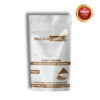
Red chilli powder is renowned for its ability to add heat and flavor to dishes, making it a beloved ingredient in cuisines worldwide. However, the science behind the heat and flavor of red chilli powder is fascinating and complex. This blog will delve into the chemistry of capsaicin, the compound responsible for the heat in chillies, explore the different varieties of red chillies used to make powder, and discuss how to balance heat in your cooking.
1. Understanding Capsaicin: The Heat Factor
1.1. What is Capsaicin?
Capsaicin is the active compound found in chilli peppers that gives them their characteristic heat. It binds to the TRPV1 receptors in our mouths, which are responsible for sensing temperature and physical abrasion. When capsaicin binds to these receptors, it creates a sensation of burning, even though no physical damage occurs. This unique interaction with our sensory receptors explains why some people enjoy spicy foods while others find them overwhelming.
1.2. Measuring Heat: The Scoville Scale
The heat level of chillies is measured using the Scoville Heat Scale, developed by Wilbur Scoville in 1912. The scale quantifies the amount of capsaicin present in a pepper, using Scoville Heat Units (SHU). For instance:
- Bell peppers have a rating of 0 SHU (no heat).
- Jalapeño peppers range from 2,500 to 8,000 SHU.
- Habanero peppers can reach up to 350,000 SHU.
- Some varieties of ghost peppers exceed 1,000,000 SHU.
When making red chilli powder, the type of chillies used significantly impacts the heat level of the final product.
2. Varieties of Chillies Used in Red Chilli Powder
Different varieties of chillies contribute unique flavors and heat levels to red chilli powder. Here are some popular varieties:
2.1. Kashmiri Chilli
Known for its vibrant red color and moderate heat level (around 1,000 to 2,000 SHU), Kashmiri chillies are often used in Indian cuisine for their rich flavor and appealing color. They are ideal for dishes like curries and gravies.
2.2. Byadgi Chilli
Hailing from Karnataka, India, Byadgi chillies have a deep red color and a smoky flavor with mild to moderate heat (around 1,000 to 15,000 SHU). They are often used in spice blends and can enhance the flavor profile of various dishes without overpowering them.
2.3. Chipotle Chilli
Chipotle chillies are smoked jalapeños with a distinctive smoky flavor and moderate heat (around 2,500 to 8,000 SHU). They add depth and complexity to dishes and are commonly used in Mexican cuisine.
2.4. Bird’s Eye Chilli
For those who enjoy intense heat, Bird’s Eye chillies are a great choice. With a Scoville rating of 50,000 to 100,000 SHU, they pack a punch. These chillies are often used in Asian cuisines and can be added to dishes for a fiery kick.
3. Balancing Heat in Cooking
When using red chilli powder in your cooking, achieving the right balance of heat can be challenging. Here are some tips to help you master this art:
3.1. Start Small
If you’re unsure of the heat level of a particular red chilli powder, start with a small amount. You can always add more, but it’s difficult to tone down heat once it’s in the dish. This approach allows you to gauge the spice level and adjust according to your taste preferences.
3.2. Pairing with Dairy
Dairy products can help neutralize the heat of chilli peppers. Incorporating ingredients like yogurt, sour cream, or cheese into your dish can provide a cooling effect and balance the spiciness. For instance, adding a dollop of yogurt to a spicy curry can create a harmonious blend of flavors.
3.3. Sweetness to Counteract Heat
Adding sweetness can also help balance heat. Ingredients like honey, sugar, or sweet vegetables (like bell peppers or carrots) can create a well-rounded flavor profile. A spicy sauce can be tempered with a touch of honey or sugar to make it more palatable.
3.4. Acidic Ingredients
Incorporating acidic ingredients such as lemon juice, lime juice, or vinegar can cut through the heat and add brightness to your dish. A splash of lime juice in a spicy salsa can enhance the overall flavor while reducing the perception of heat.
4. Creative Ways to Use Red Chilli Powder
Here are some ideas for incorporating red chilli powder into your cooking while maintaining a balanced flavor:
4.1. Spicy Tomato Sauce
Create a flavorful tomato sauce by sautéing onions and garlic, adding crushed tomatoes, and then incorporating red chilli powder to taste. Balance the heat with a pinch of sugar and a splash of vinegar for a delicious pasta sauce.
4.2. Chili Garlic Noodles
Prepare a simple noodle dish by cooking your favorite noodles and tossing them with sautéed vegetables, soy sauce, and red chilli powder. Adjust the heat to your liking and serve with lime wedges for a refreshing kick.
4.3. Spicy Marinade for Grilled Chicken
Mix olive oil, red chilli powder, garlic, lemon juice, and herbs to create a marinade for grilled chicken. Allow the chicken to marinate for a few hours to infuse it with flavor and heat.
5. Conclusion
Red chilli powder is not just a spice; it’s a complex ingredient with a rich history and scientific basis. Understanding the chemistry of capsaicin, the different varieties of chillies, and the methods to balance heat in your cooking can enhance your culinary skills and appreciation for this fiery spice. Whether you enjoy mild flavors or crave intense heat, red chilli powder can elevate your dishes and bring warmth to your meals. Embrace the science behind this spice, and experiment with it in your kitchen to discover new flavors and culinary delights.






